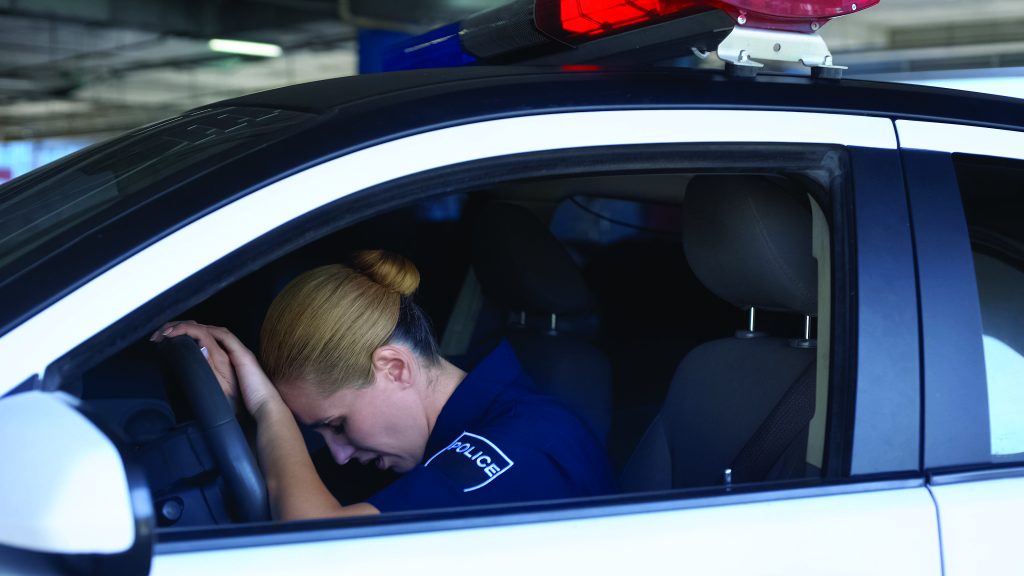
Features
The hidden cost of sick leave for police departments: Creating policies to control and manage viral spread during flu season
December 1, 2023 By Ronald D. Brown
 Photo credit: motortion / Adobe Stock
Photo credit: motortion / Adobe Stock There has never been a more important time to assess the intradepartmental effects of viral spread on law enforcement. The recent pandemic brought to light many staffing issues facing departments nationwide. As a profession, law enforcement inherently entails close contact work with strangers, many of whom have minimal access to medical care when suffering from a viral disease like influenza, RSV or COVID-19. However, lessons from the recent pandemic have created applicable and effective best practices to prevent viral spread, save departments thousands of dollars in sick leave, and help officers better serve their communities.
Overworked officers and correctional facility employees often feel pressure against taking the proper time off to recuperate from an illness. Sadly, that can often do more harm than good. According to a 2022 study published by the International Journal of Environmental Research & Public Health1, 92 per cent of prison officers interviewed reported working while unwell at least sometimes, with 43 per cent reporting that they always did so, potentially endangering their department. However, refusing to take off work can have lasting and potentially life-threatening consequences.
A National Academy of Sciences2 case study details a 2003 SARS outbreak in Toronto, wherein an infected employee came to work sick and exposed their team. This single exposure required the department to quarantine 49 people for 10 days, rendering them incapable of performing their duties. While many within the profession feel a moral obligation to continue working through an illness, preventable situations like these can cause an immediate threat to both their jurisdiction and fellow officers.
Recent drops in law enforcement employment have exacerbated many departments’ ability to cover unplanned sick leave and severely increased their budget for overtime. According to a recent Police Executive Research Forum Study3, the number of workers in law enforcement, including officers and civilian employees, fell by 3.5 per cent between 2019 and 2021, with little to no improvement in the past year. Already understaffed departments simply cannot afford the temporary loss of officers due to an active contagion.
In response to the COVID-19 pandemic, The Vera Institute of Justice4 outlined multiple methods to bolster prevention, limit the viral spread and create a rapid response plan in case of a department-wide viral outbreak. Although available vaccines and proper treatments have lessened the threat of COVID-19, these safety methods continue to be relevant for maintaining department health and safety against future airborne illnesses.
To effectively control and manage viral spread, departments must create a clear policy regulating leave, tracking each employee’s use of sick leave, and taking corrective action when abuses or under usages occur. Simple measures like these and consistent education on proper usage can save departments thousands of dollars in overtime pay.
Prevention techniques alleviate stress so that law enforcement officials can properly handle low-staff situations. Equipping 911 dispatchers to divert more service calls for health resources to deal with situations that do not require a police response can potentially prevent the dangerous spread of infectious diseases. Agency leaders should limit one-on-one meetings without proper personal protective equipment (PPE) during high-risk seasons. Deploying or expanding the use of online reporting options for complaints or police reports can limit one-on-one contact and allow for remote police report coordination. Departments can also utilize tools like videoconferencing to provide briefings, instead of roll-call meetings, minimizing unnecessary interaction during an active flu season.
Prevention also relies on a consistent cleaning regimen. Many law enforcement agencies proactively use no-touch decontamination5 systems to regularly clean vehicles in minutes between patrols and transport with aerosolized cleaning fluid. These devices can safely disinfect entire rooms with chemical compounds that are safe around firearms, radios, computers and tactical gear. However, a cleaning device itself cannot perform all the required actions of a thorough decontamination; officers must also practice proper personal and equipment sanitization techniques.
Police departments can work with their local hospitals to provide routine education on the spread of infectious diseases, modes of transmission and points of entry for diseases (including the nose, eyes and mouth). Hand sanitizing methods like handwashing, antibacterial gels and antimicrobial wipes are the simplest, easiest and most effective forms of personal protection. Even in an epidemic, constant hand washing can slow the spread of disease.
New viral threats will continue to emerge globally. Law enforcement agencies simply cannot afford a significant temporary loss of employees due to illness. By utilizing the strategies outlined above, officers can be better prepared to handle future public health crises as they arise.
References
- Kinman, Gail and Andrew J. Clements. “Sickness Presenteeism in Prison Officers: Risk Factors and Implications for Wellbeing and Productivity.” International Journal of Environmental Research & Public Health, 19(6). March 2022. Accessed at https://www.ncbi.nlm.nih.gov/pmc/articles/PMC8949989/.
- Low, Donald E. “Sars: Lessons from Toronto.” National Library of Medicine. 2004. Accessed at https://www.ncbi.nlm.nih.gov/books/NBK92467/.
- “PERF survey shows steady staffing decrease over the past two years.” Police Executive Research Forum. 2022. Accessed at https://www.policeforum.org/workforcemarch2022.
- “Guidance for preventive and responsive measures to coronavirus by police and law enforcement.” Vera Institute of Justice. 2020. Accessed at https://www.vera.org/downloads/publications/coronavirus-guidance-police-law-enforcement.pdf.
- Otter, J.A, Yezli, S., et al. “A guide to no-touch automated room disinfection (NTD) systems.” Decontamination in Hospitals and Healthcare. 2014. Accessed at https://www.ncbi.nlm.nih.gov/pmc/articles/PMC7152068/.
Ronald D. Brown, MD, has decades of experience in emergency medicine, acting as the EMS Medical Director for the Seminole County Department of Public Safety from 1985-2000.
Print this page